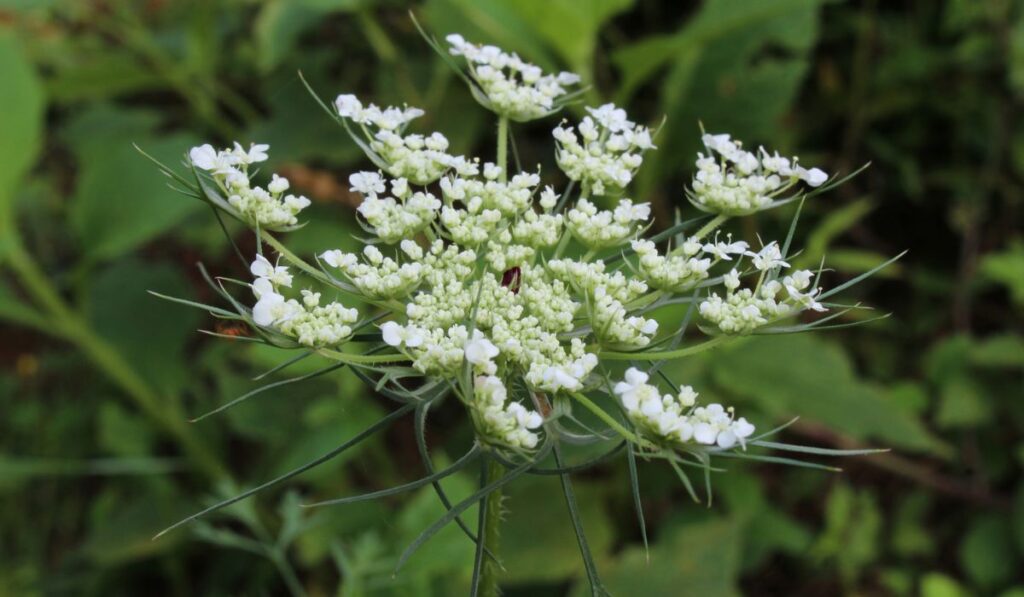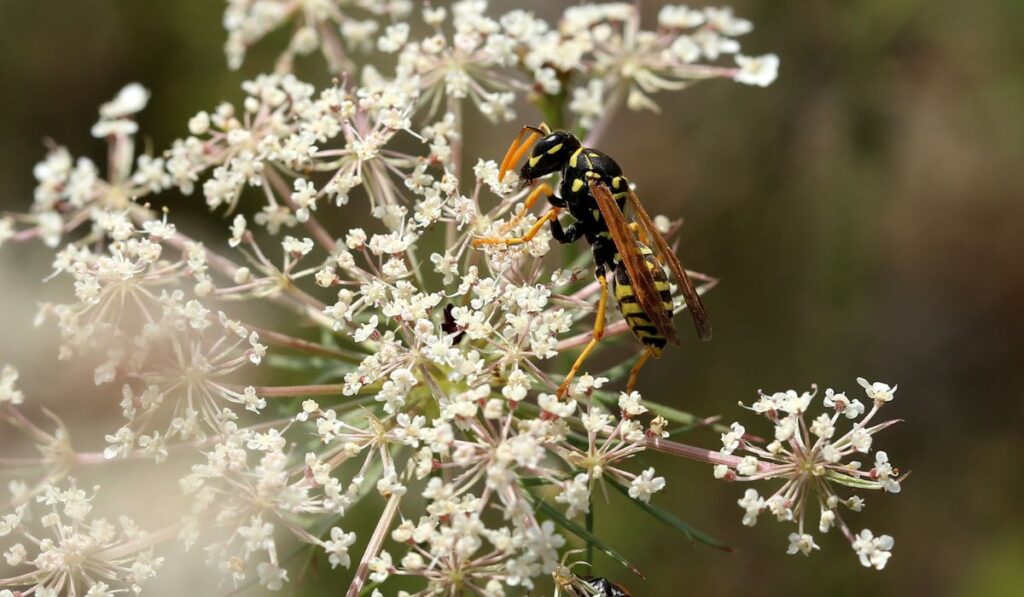Not to be confused with its poisonous lookalike, Queen Anne’s Lace (also known as wild carrot) is a wildflower herb found all over the USA. Originally from Europe, the herb is associated with Queen Anne of England and her fondness for making lace. But how exactly do you plant and take care of Queen Anne’s Lace, and when’s the best time to do so?
Queen Anne’s Lace is relatively easy to plant and care for. You can plant the seeds in late spring, though it should thrive in any temperature that’s at least mild. In some states, it’s considered invasive, so make sure you check out local laws before planting. It will also spread very rapidly.
Let’s take a closer look at growing Queen Anne’s Lace, including the best time to plant it, how to make sure it thrives, and how to protect it from pests and other problems that may arise.
What Is Queen Anne’s Lace?
Queen Anne’s Lace is a wildflower herb that’s also commonly known as wild carrot. Nowadays, it occurs naturally in many parts of the US, although it originated in Europe. Many people enjoy the white plant’s delicate appearance, which can add a great accent to any garden, but it’s also considered an invasive weed by many.
You can recognize Queen Anne’s Lace by its tiny white flowers that surround a dark-colored one. It’s named after Queen Anne I of England, who was very good at making lace. Some say that she once pricked her finger and left a drop of blood on her white lace, mimicking the dark-colored part that appears in the center of the plant.
Another story behind the plant’s name is that it comes from Queen Anne’s headdress, which was made of white lace.
Although we can be pretty certain that the plant was named after one of the English queens named Anne, there are many discussions and theories as to why, and no one knows for sure.
When Is the Best Time to Plant Queen Anne’s Lace?

It’s not difficult to find the right time to plant Queen Anne’s Lace since it’s not fussy about the conditions in which it will grow. However, it won’t survive freezing temperatures, so the best time to plant is in the spring, right after the last frost has passed.
If you choose to plant Queen Anne’s Lace in the summer or the beginning of fall, it will most likely still thrive. However, the beginning of fall may be too late in some colder states. It’s important to take into account your own state’s climate, as they can vary wildly.
Is Queen Anne’s Lace Annual or Perennial?
While annual plants grow once in a year before dying and perennial plants come back every year, Queen Anne’s Lace falls somewhere in the middle. It’s what’s known as a biennial plant.
This means that it spends the first year establishing a good base from which to grow flowers and building up its strength. The second year is when the flowers really grow. After that, it will die, and you’ll have to plant it again if you want the flowers to continue to enhance your garden.
How to Plant Queen Anne’s Lace
You’ll want to begin sowing Queen Anne’s Lace seeds (from Amazon) indoors before the last frost passes. For the best results, start around eight weeks prior. Then, when it’s time, you can take the plant outside.
How to Care for Queen Anne’s Lace
Because it doesn’t require fertilization, Queen Anne’s Lace is considered an extremely low-maintenance plant. For the best results and to keep it growing, you’ll have to water the plant every now and again — but that’s all. When the cold starts to set in, the plant will naturally curl inward, holding its seeds inside like a nest.
Pest and Diseases

There are a few bugs that might be attracted to your Queen Anne’s Lace, such as mites. You don’t need to worry too much about them; for the most part, this is a robust plant and it take’s a lot to kill it.
However, if you want to keep the bugs away, you can always spray the plant lightly with vegetable oil (on Amazon) and that should help.
If you’re concerned about mice or rats, you can surround the plants with garlic or onion. This is known to be a rodent deterrent.
Is Queen Anne’s Lace Dangerous?
Although it’s often confused with a poisonous plant that looks similar, Queen Anne’s Lace isn’t dangerous to most people.
However, those with certain sensitivities or allergies may come out with rashes and blisters after prolonged contact with Queen Anne’s Lace. It’s best to wear gardening gloves (on Amazon) when dealing with the plant, or make sure beforehand that you don’t have any of these sensitivities.
The leaves may also be poisonous to dogs in large doses. Make sure you keep your pup away or have the plant out of reach, particularly if your dog likes to digest things they shouldn’t. If your dog does digest any of the plant, it’s probably nothing to worry about — but seek medical attention just in case.
Tips for Growing Queen Anne’s Lace
For the best results when growing Queen Anne’s Lace, follow these tips.
Check Local Laws
Before you go ahead with growing Queen Anne’s Lace, the best thing you can do is check out local laws. Many states ban this plant because it’s invasive.
Counties and cities also have their own laws, so you should make sure you’re aware of the rules on every level or you may face a hefty fine — even if it’s contained to your garden.
Don’t Get It Confused With Poison Hemlock
Poison hemlock can look very similar to Queen Anne’s Lace, so it’s important to know the difference. Poison hemlock has purple splotches on its smooth stem, whereas Queen Anne’s Lace has a green stem and is hairy.
Have a Plan to Contain It
The worst thing about Queen Anne’s Lace is the fact it can grow very rapidly when it’s not properly contained. Make sure you have a fence or something else to keep it from spreading out of your garden.
Even if there aren’t laws against the plant where you live, it can become quite a hassle when it gets out of hand.
Plant It in a Sunny Spot
Like most plants, Queen Anne’s Lace needs a good amount of sun to grow. Make sure it’s not hidden by too much shade for most of the day. Since this plant isn’t too high-maintenance, though, it can still grow fine in the partial sun — it just won’t provide the best possible results.
Deadhead Plants
As well as creating barriers so your plants can’t grow beyond control, deadheading them is also a good idea. Since this plant grows so rapidly, you shouldn’t have to worry about overdoing it.
Water It Frequently
As with most plants, you’ll still have to water your Queen Anne’s Lace. Once a week should do it, as they don’t need too much water to survive.
Be Patient
Queen Anne’s Lace isn’t usually very impressive in the first year; it takes time to grow. For this reason, many people who are new to the plant are often disappointed when they see that isn’t moving on quickly. They might even assume they haven’t been successful in growing the plant.
The second year is when you’ll really notice the plant thriving, as long as you’ve done everything right. Fortunately, they’re very forgiving of any mistakes!
The Final Word
Overall, Queen Anne’s Lace is an excellent plant for a beginner since it can thrive under many conditions and with very little care. It doesn’t need fertilizer and requires minimum watering.
The main challenges are ensuring that the plant is legal to grow in your area and that you can control the growth. Deadhead the plant where necessary and create barriers to ensure it doesn’t spread beyond the area where you want it.
